List of churches in the parish of Arnstadt-Ilmenau
The list of churches in the Arnstadt-Ilmenau parish includes the churches in this parish that belongs to the Meiningen-Suhl provost in the Evangelical Church in Central Germany . Its area largely corresponds to that of the Ilm district in Thuringia , its seat is in Arnstadt . The 93 parishes of the parish have around 20,000 parishioners who are looked after by 21 pastors. The superintendent is Angelika Greim-Harland, her deputy is Stefan Wohlfarth. The chairman of the district synod is Horst Brettel (as of November 2016). The 94 churches in the parish include several former fortified churches as well as other very old, partly Romanesque churches.
List of churches
| Parish | place | church | Remarks | image |
|---|---|---|---|---|
| Angelhausen-Oberndorf | Angelhausen | St. John's Church | Built in the first half of the 12th century, expanded and rebuilt in the 18th and 19th centuries, then unused for a long time in the late 20th century, renovated 1994–2006. |

|
| Angelhausen-Oberndorf | Oberndorf | Parish Church of St. Nicolai | The church is one of the best preserved Romanesque village churches in Thuringia. |

|
| Angelhausen-Oberndorf | Dornheim | St. Bartholomew | The church was Johann Sebastian Bach's wedding church in 1707 . |

|
| Arnstadt | Arnstadt | Church of Our Lady | The core of the church dates from the 12th and 13th centuries and is the oldest church in Arnstadt and one of the most important church buildings in Thuringia. |

|
| Arnstadt | Upper Church | The church goes back to a Franciscan monastery built in the 13th century. Its tower dates from 1461. Johann Sebastian Bach's great uncle Heinrich (1615–1692) was the organist at the Ober- und Liebfrauenkirche for 51 years |

|
|
| Arnstadt | Johann Sebastian Bach Church | The building goes back to the Bonifatiuskirche mentioned in 1333, which was rebuilt after a fire in 1687. In 1703 Johann Sebastian Bach , just 18 years old, took over the new organ from master organ builder Johann Friedrich Wender and took over the position of organist until 1707. The church was named after Bach's 250th birthday in 1935. |

|
|
| Arnstadt - Rudisleben | Johanniskirche | Built on a cross-shaped floor plan in 1732 on the site of a previous building that had burned down. |

|
|
| Arnstadt | Chapel in the Marienstift | The chapel was consecrated in October 2000 and has a modern winged altar by Friedrich Popp and glass windows by Jakobus Klonk . | ||
| Dienstedt | Dienstedt | Village church | Former fortified church , nave from the 18th century. After falling into disrepair from the 1970s, the church was consecrated again in 1991. |

|
| Grosshettstedt | Village church | The towerless church has two circumferential galleries . | ||
| Kleinhettstedt | Village church | The chancel wall-filling pulpit altar of the church is decorated with carvings and pictures. |

|
|
| Elxleben | Elxleben | St. Peter and Paul | Built 1722–1725, with a historic Volckland organ. |

|
| Elxleben | Gügleben | St. Gangolf | The village church of St. Gangolf is built from field stones and was completed in 1697 on the foundation walls of a previous building. This is evidenced by a window sill stone in the south wall of the church. In 1847 the church tower was given a new structure, easily recognizable by the change in the masonry at about half the height of the tower. The present organ was built into the church in 1860. The Protestant parish belongs to the Elxleben parish . |

|
| Elxleben | Elleben | Village church | Baroque village church from 1729, with winged altar by Valentin Lendenstreich from 1498. |

|
| Elxleben | Alkersleben | St. Gregorius | Last extended in the 15th century, with an altar by Christoph Meil from 1706. Baptistery by Adam Drese (1620–1701), who was court music director in Arnstadt from 1683 until his death after stints in Merseburg, Weimar and Jena. |

|
| Elxleben | Et table life | Village church | The church dates back to a Romanesque chapel from the 12th century and was expanded to its present form in 1508. |

|
| Elxleben | Smell home | Village church | Erected in 1647 in place of the Gallus Church, which burned down in 1646. |

|
| Aspenfield | Aspenfield | St. Crucis | The old fortified church is still surrounded by a four meter high wall in the south. An old stone altar has been preserved in the choir in the tower base. |

|
| Siegelbach | St. Remigius | Old fortified church with preserved fortified tower with roofed battlements . |

|
|
| Dosdorf | St. Otmar | The old church of Romanesque origin has a medieval carved altar. |

|
|
| Miter | Miter | St. Michael | Built between 1830 and 1834 in place of a previous church that had burned down, which had replaced the historical church of the place located elsewhere only 30 years earlier. |

|
| Jesuborn | Village church | Built 1817–1819 in place of an older chapel, with a font from 1614. |

|
|
| Möhrenbach | Village church | Built in 1818 instead of a church from 1659 that burned down in 1811. |

|
|
| Geraberg | Geraberg | St. Bartholomew | Baroque building on the site of two previous buildings. |

|
| Elgersburg | St. Nicholas | The interior of the baroque building was renovated in 1999. |

|
|
| Angelroda | Village church | The core of the tower dates from the 12th century, the nave from the 17th century. The outside of the church was renovated in the 1990s and the organ was restored in 2002. |

|
|
| Martinroda | Village church | Parts of the church date from the Gothic period , other parts are baroque from 1720. The interior of the church was renovated in 1999. |

|
|
| Neusiss | Village church | Built in 1841/42 instead of a previous structure. |

|
|
| Gillersdorf | Gillersdorf | Village church | Built in 1829 instead of a previous structure that burned down in 1825. Common church for Gillersdorf and Friedersdorf. |

|
| Willmersdorf | Village church | The church was only built in 1937 and is one of the youngest churches of the superintendent. It was renovated in 1987. |

|
|
| Pennewitz | Village church | Built in 1867, extensively renovated in 2001. |

|
|
| Cooking seat | Restaurant Zum Gebörne | The inn is used for Protestant church services after the town's schoolhouse was used as a church service room from 1893. |

|
|
| Dörnfeld an der Heide | St. Stephen | The church goes back to pre-Reformation times and was rebuilt in 1680 and 1705-1727. Bell house from 1703, renovated in 1997. | ||
| Gräfinau-Angstedt | Gräfinau-Angstedt | church | The old church was consecrated to Maria, Nicolai and all saints according to a document from 1281. The current church was built between 1827 and 1831 in the classicism style on the site of the previous building. The church has a bell from 1512 and a Gothic lamentation group on the altar. |

|
| Wumbach | Village church | The tower and retaining wall date from 1599, the church was expanded and rebuilt in 1727 and 1756. |

|
|
| Bücheloh | Village church | The church has a Romanesque tower with a Gothic extension and a newer nave. The baroque interior is by Heinrich Christoph Meil , more recent paintings on the nave date from 1934. |

|
|
| Griesheim | Griesheim | Maria Magdalena village church | The church was first mentioned in the 14th century and has a very old tower. The younger nave dates from the 17th century. |

|
| Cottendorf | Village church | Built as a solid construction from natural stone in the 17th / 18th centuries Century |

|
|
| Dörnfeld on the Ilm | Village church | Built in 1901/02 in the neo-Gothic style. |

|
|
| Geilsdorf | Village church | Built in 1882 in the neo-Romanesque style. |

|
|
| Local winds | Village church | Solid construction with a tower facing east. |

|
|
| Dollstedt | Village church | Built in 1870 in neo-Gothic style on the site of a previous building. |

|
|
| Ehrenstein | Village church | The nave was built around 1730. |

|
|
| Großbreitenbach | Großbreitenbach | Trinity Church | Built in 1680/90 as a wooden church on a broken stone base. |

|
| Bohlen | St. Anne's Church | Built in 1822 instead of a previous structure, with a winged altar from the circle of the master of the Meckfeld altar. |

|
|
| Holzhausen | Holzhausen | Trinity Church | The church was built around 1480 and rebuilt in the Baroque period. The church has a Hess organ from 1789. |

|
| Bittstädt | Aegidia Church | The church was renovated in 1985. |

|
|
| Ichtershausen | Ichtershausen | Monastery church | The church goes back to the Ichtershausen Monastery, which was founded in 1141 and closed at the time of the Reformation . |

|
| Eischleben | St. Matthias village church | The church probably goes back to a chapel that was subordinated to the Ichtershausen monastery in 1157. It was renewed in 1744. |

|
|
| Molsdorf | St. Trinity | In place of an older Albans church, rebuilt between 1717 and 1720. With paintings by the Liebermann student Hedwig Ruetz . |

|
|
| Rehestädt | St. Gangolf village church | The church was built in 1719 instead of a previous building. |

|
|
| Thörey | St. Wenceslas village church | The oldest components of the church date from around 1100. The church was expanded and decorated between the 12th and 14th centuries, the rectangular choir dates from the late Gothic period, and the nave was lengthened and raised in 1616. |

|
|
| Rockhausen | St. Elisabeth | The church was built in 1690, the top of the tower is from 1798/99. The building was renovated in 1981. In 2000 the church of St. Elisabeth of Thuringia was consecrated. |

|
|
| Ilmenau | Ilmenau | St. James Church | Tower base and chancel from the 15th century, largely rebuilt after fire in 1761/69. |
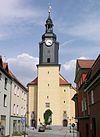
|
| Ilmenau | Kreuzkirche | The cruciform church on the Ilmenau cemetery was built in 1851/52 instead of an older cemetery church that was demolished in 1836. |

|
|
| Ilmenau-Roda | Ilmenau-Roda | Village church | The core of the church goes back to the 14th century. |

|
| Manebach | Zum-Kripplein-Jesu-Kirche | Built in 1682, renovated in 1956/57. |
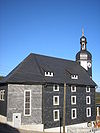
|
|
| Langewiesen | Langewiesen | Church of Our Lady | Built between 1675 and 1680 instead of a previous structure that burned down in 1675. |

|
| Oehrenstock | Village church | Built 1737–1739, reconstructed 1987–1990. |

|
|
| Marlishausen | Marlishausen | St. Peter and Paul | The church is of Romanesque origin and was partly Gothic, partly Baroque. It has a late Gothic pulpit altar and was extensively renovated by 2004. |

|
| Branchewinda | St. James the Elder Ä. | Apse hall from the 12th century, with late Gothic winged altar. |

|
|
| Dannheim | St. Boniface | Built 1775–1777 on the site of a previous building. |

|
|
| Goerbitzhausen | St. Johannis | In the core Romanesque, rebuilt several times from the 17th to the 19th century. |

|
|
| Hausen | St. Nicholas | In the core Romanesque, rebuilt several times from the 15th to the 19th century. |

|
|
| Wüllersleben | Village church | Gothic church tower with nave from 1822. |

|
|
| Neuroda | Neuroda | Village church | Built in 1740 according to plans by JE Straussberger instead of a previous structure that burned down in 1738. |

|
| Kettmannshausen | Village church | In the core Romanesque, with baptismal font from 1597. |

|
|
| Schmerfeld | Village church | Romanesque core, with round apse, renovated in 2001 inside. |

|
|
| Traßdorf | Village church | Erected in 1898 instead of a previous structure. |

|
|
| Reinsfeld | Village church | Oldest church in the Wipfra Valley , Romanesque core. |

|
|
| Wipfra | Village church | Romanesque core, former fortified church with battlements and gatehouse. |

|
|
| Neustadt am Rennsteig | Neustadt am Rennsteig | Michaeliskirche | The church was consecrated in 1859 and is also called Meiningen Church due to its location in the part of the village that once belonged to Saxony-Meiningen . |

|
| Neustadt am Rennsteig | Schwarzburg Church | The church was consecrated in 1887 and takes its name from its location in the part of the village that once belonged to Schwarzburg-Sondershausen . |

|
|
| Altenfeld | Village church | Delivered half-timbered church, built in 1741 in the baroque style. |

|
|
| Oberwillingen | Oberwillingen | St. Martin village church | The oldest parts of the church date from the 10th century, only the tower and choir of the church have survived, with the choir serving as a place of worship. |

|
| Niederwillingen | St. Peter and Paul | The core from the 14th century, extended to the east in 1786, restored 1991–1994. |

|
|
| Behringen | Village church | Built in 1717 by the Thumshiern manor. |
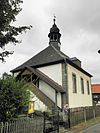
|
|
| Roda | Village church | Built in 1861 in half-timbered construction. |

|
|
| Grandchildren | Village church | First mentioned in 1119, last extensively renovated in 1900. |
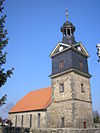
|
|
| Small charms | Village church | Romanesque core, renovated in 2001. | ||
| Plaue | Plaue | Church of Our Lady | The church dates back to a chapel around the year 1000. |

|
| Love stone | Village church | Built in 1812 using details from a previous building. |
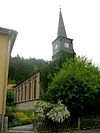
|
|
| Kleinbreitenbach | Village church | Former fortified church, partially renovated in 1696/97 and 1797, with winged altar from the early 16th century. |

|
|
| Rippersroda | Village church | Built in 1637 on the site of a previous building, the half-timbered sacristy was added in the 19th century. |

|
|
| To sing | To sing | St. Nicolai | Built 1742–1745, with pulpit altar by Samuel Dörnberg , renovated in 1996. |

|
| Gösselborn | St. Nicolai | Built in 1688 on the site of a previous building, rebuilt in 1892. |

|
|
| Hengelbach | Village church | Built in 1683 on the site of a previous building. Tower from 1804, renewed in 1875 and 1950. |

|
|
| Paulinzella | Paulinzella Monastery | The Romanesque monastery ruins are used for church services. |

|
|
| Stadtilm | Stadtilm | City Church of St. Mary | The church was founded in 1235. The tower vault shows paintings from the time of the foundation, the church has 42 meter high double towers. |

|
| Stadtilm - Oberilm | Oberilm village church | The core of the pre-Reformation period, once dedicated to St. Severin, rebuilt several times. |

|
|
| Brawn bridges | Brawn bridges | St. Wiperti | With wall remains of a church castle , oldest parts around 1050, tower base from 1200. |

|
| Haarhausen | Nikolaikirche | The core dates from around 1184, the tower was raised to 33 meters in 1557, and half of the church was renovated in 1684–1703 because it was dilapidated. Renovated after fire from 1972 to 1979. |
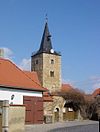
|
|
| Unterpörlitz | Ilmenau - Unterpörlitz | Unterpörlitz village church |

|
|
| Heyda | Village church | From the baroque period. |

|
|
| Joke life | Joke life | Village church of St. Magdalenen | In essence from the 12th / 13th Century, pulpit extension from 1686. |

|
| Achelstädt | Village church | The church is said to go back to a building around 750. Tower in its core Romanesque, nave from 1857. |

|
|
| Wülfershausen | St. Vitus village church | Romanesque core, tower from 1586 with pointed helmet from the 18th century. With winged altar by Valentin Lendenstreich from 1499. |

|
|
| Ellichleben | To the peace of God | Built in 1720, with a Gothic font as well as a pulpit and organ from the second half of the 18th century. |

|
|
| Evil life | Village church | Built in 1893, goes back to the original church of the place, which was built in 1150 in place of a wooden chapel. |
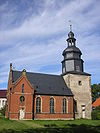
|
|
| Osthausen | St. James | Built around 1500 on the site of a chapel mentioned around 1235. |
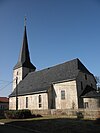
|
literature
- Superintendent of Arnstadt-Ilmenau: Churches of the Superintendent of Arnstadt-Ilmenau , Arnstadt 2002